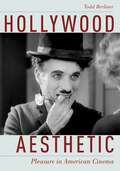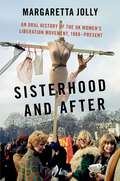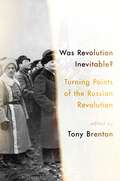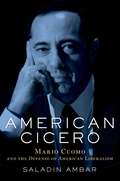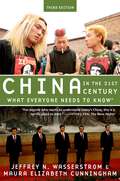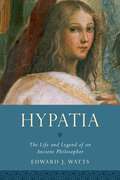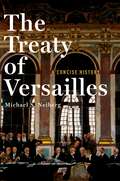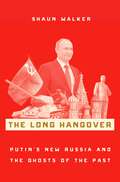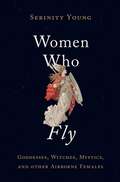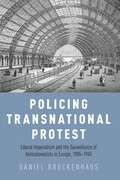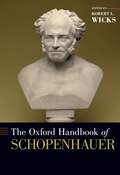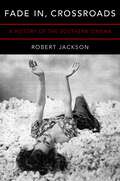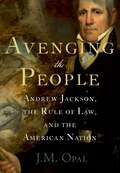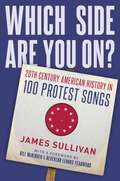- Table View
- List View
Hollywood Aesthetic: Pleasure in American Cinema
by Todd BerlinerHollywood makes the most widely successful pleasure-giving artworks the world has ever known. The industry operates under the assumption that pleasurable aesthetic experiences, among huge populations, translate into box office success. With that goal in mind, Hollywood has systematized the delivery of aesthetic pleasure, packaging and selling it on a massive scale. In Hollywood Aesthetic, Todd Berliner accounts for the chief attraction of Hollywood cinema worldwide: its entertainment value. The book examines films such as City Lights and Goodfellas that have earned aesthetic appreciation from both fans and critics. But it also studies some curious outliers, cult films, and celebrated Hollywood experiments, such as The Killing and Starship Troopers. And it demonstrates that even ordinary popular films, from Tarzan and His Mate to Rocky III, as well as action blockbusters, like Die Hard and The Dark Knight, offer aesthetic pleasure to mass audiences. Hollywood Aesthetic explains how Hollywood engages viewers by satisfying their aesthetic desires. Visit the companion website at www.oup.com/us/hollywoodaesthetic
Hollywood Aesthetic: Pleasure in American Cinema
by Todd BerlinerHollywood makes the most widely successful pleasure-giving artworks the world has ever known. The industry operates under the assumption that pleasurable aesthetic experiences, among huge populations, translate into box office success. With that goal in mind, Hollywood has systematized the delivery of aesthetic pleasure, packaging and selling it on a massive scale. In Hollywood Aesthetic, Todd Berliner accounts for the chief attraction of Hollywood cinema worldwide: its entertainment value. The book examines films such as City Lights and Goodfellas that have earned aesthetic appreciation from both fans and critics. But it also studies some curious outliers, cult films, and celebrated Hollywood experiments, such as The Killing and Starship Troopers. And it demonstrates that even ordinary popular films, from Tarzan and His Mate to Rocky III, as well as action blockbusters, like Die Hard and The Dark Knight, offer aesthetic pleasure to mass audiences. Hollywood Aesthetic explains how Hollywood engages viewers by satisfying their aesthetic desires. Visit the companion website at www.oup.com/us/hollywoodaesthetic
Sisterhood and After: An Oral History of the UK Women's Liberation Movement, 1968-present (Oxford Oral History Series)
by Margaretta JollyThis ground-breaking history of the UK Women's Liberation Movement shows why and how feminism's 'second wave' mobilized to demand not just equality but social and gender transformation. Oral history testimonies power the work, tracing the arc of a feminist life from 1950s girlhoods to late life activism today. Peppered with personal stories, the book casts new light on feminist critiques of society and on the lives of prominent and grassroots activists. Margaretta Jolly uses oral history as creative method, making significant use of Sisterhood and After: The Women's Liberation Oral History Project to animate still-unresolved controversies of race, class, sexuality, disability, and feminist identity. Women activists vividly recall a divisive education system, the unevenness of sexual liberation and the challenges of Thatcherism, Northern Ireland's Troubles and the policing of minority ethnic communities. They illuminate key campaigns in these wider contexts, and talk of the organizational and collaborative skills they struggled to acquire as they moved into local government, NGOs and even the business sector. Jolly provides fresh insight into iconic actions including the Miss World Protest, the fight to protect abortion rights, and the peace protest at Greenham Common. Her accounts of workplace struggles, from Ford and Grunwick to Women Against Pit Closures and Women and Manual Trades, show how socialist ideals permeated feminism. She explores men's violence and today's demands for trans-liberation as areas of continuing feminist concern. Jolly offers a refreshingly jargon-free exploration of key debates and theoretical trends, alongside an appreciation of the joyfully personal aspects of feminism, from families, homes, shopping and music to relationships, health, aging, death and faith. She concludes by urging readers to enter the archives of feminist memory to help map their own political futures. Her work will appeal to general readers, scholars and practitioners alike.
Sisterhood and After: An Oral History of the UK Women's Liberation Movement, 1968-present (Oxford Oral History Series)
by Margaretta JollyThis ground-breaking history of the UK Women's Liberation Movement shows why and how feminism's 'second wave' mobilized to demand not just equality but social and gender transformation. Oral history testimonies power the work, tracing the arc of a feminist life from 1950s girlhoods to late life activism today. Peppered with personal stories, the book casts new light on feminist critiques of society and on the lives of prominent and grassroots activists. Margaretta Jolly uses oral history as creative method, making significant use of Sisterhood and After: The Women's Liberation Oral History Project to animate still-unresolved controversies of race, class, sexuality, disability, and feminist identity. Women activists vividly recall a divisive education system, the unevenness of sexual liberation and the challenges of Thatcherism, Northern Ireland's Troubles and the policing of minority ethnic communities. They illuminate key campaigns in these wider contexts, and talk of the organizational and collaborative skills they struggled to acquire as they moved into local government, NGOs and even the business sector. Jolly provides fresh insight into iconic actions including the Miss World Protest, the fight to protect abortion rights, and the peace protest at Greenham Common. Her accounts of workplace struggles, from Ford and Grunwick to Women Against Pit Closures and Women and Manual Trades, show how socialist ideals permeated feminism. She explores men's violence and today's demands for trans-liberation as areas of continuing feminist concern. Jolly offers a refreshingly jargon-free exploration of key debates and theoretical trends, alongside an appreciation of the joyfully personal aspects of feminism, from families, homes, shopping and music to relationships, health, aging, death and faith. She concludes by urging readers to enter the archives of feminist memory to help map their own political futures. Her work will appeal to general readers, scholars and practitioners alike.
Was Revolution Inevitable?: Turning Points of the Russian Revolution
by Tony BrentonCommunism's rise and eventual fall in Eastern Europe is one of the great stories of the 20th century. Within this context, the Russian Revolution's role and legacy overshadows all else. In Was Revolution Inevitable?, former British Ambassador to Russia Sir Tony Brenton has gathered essays by leading historians to trace the events that led to the overthrow of the Tsarist regime and to pinpoint moments when those events could have unfolded in a drastically different way. What would the world be like had Fanny Kaplan succeeded in assassinating Vladimir Lenin in 1918? What if the Bolsheviks had never imposed the brutal "War Communism" initiatives that devastated the Russian peasants? What if Rasputin had talked Nicholas II out of involvement in World War One, which effectively led to the Revolution and sealed the demise of the Romanov dynasty? Preeminent scholars, including Orlando Figes, Richard Pipes, Douglas Smith, and Martin Sixsmith, ruminate on these questions and many others, assembling a series of pivotal moments that reveal what might have gone differently, and, if so, what the repercussions would have been. The contributors take a variety of approaches, from imagining an alternate history, to carefully studying a precarious moment of contingency, to disproving popular imagined alternatives. All of the chapters, however, shed light on Lenin's rise to power and the proliferation of his agenda, while assessing the influence of the revolution's pivotal moments on Russian-and global-politics. Provocative and illuminating, Was Revolution Inevitable? provides an in-depth exploration of the conflict that for nearly a century has shaped world history. The Russian Revolution put totalitarian communism into power, fueled Nazism and the Second World War, and forged one of the West's greatest antagonists. Here is a book that scrutinizes how the past, present, and future of global history could have been remarkably different had the events of 1917 unfolded differently and in the process deepens our understanding of what did happen and why.
American Cicero: Mario Cuomo and the Defense of American Liberalism
by Saladin AmbarMario Cuomo was the most important Democratic officeholder during the Reagan era. The three-term governor of New York was also a famously eloquent defender of the Democratic Party's progressive legacy even as conservatives gained political power across the nation. As liberalism's most powerful and eloquent defender of the New Deal's legacy, he found a wide and receptive audience well beyond his home state of New York. Yet he never ran for president. Why? Saladin Ambar's American Cicero traces Cuomo's rise from the rough-and-tumble world of New York City politics to liberal champion, and a central question threads throughout the narrative: was he a symbol of liberalism's long decline in twentieth-century American politics, or a prophet in the wilderness, heralding the rise of a new progressivism? Moving from his youth in an immigrant neighborhood in Queens to his final years in Albany, Ambar argues that Cuomo kept the spent embers of liberalism alive in an era of conservative dominance. Cuomo's voice - buttressed by a string of electoral victories in New York - provided succor to the liberal faithful. Yet his decision not to run for president arguably hastened the end of his political career: he was voted out of gubernatorial office in 1994 in a nationwide Republican wave. Ambar's research took him to Italy in search of lingering questions, chiefly why Cuomo never ran for president. He learned of concerns about an assassination attempt - Cuomo's mother had admonished him, "remember what happened to the last Catholic president" - and even proto-"birther" rumors that Cuomo had been born in Italy. Whatever clinched his decision not to run, Cuomo's impassioned advocacy for liberalism nevertheless had a measurable impact on twenty-first century Democratic progressives, notably Barack Obama. American Cicero promises to not only re-establish Cuomo's central place in modern American liberalism, but also force readers to reassess liberalism's fortunes following the close of the New Deal era.
American Cicero: Mario Cuomo and the Defense of American Liberalism
by Saladin AmbarMario Cuomo was the most important Democratic officeholder during the Reagan era. The three-term governor of New York was also a famously eloquent defender of the Democratic Party's progressive legacy even as conservatives gained political power across the nation. As liberalism's most powerful and eloquent defender of the New Deal's legacy, he found a wide and receptive audience well beyond his home state of New York. Yet he never ran for president. Why? Saladin Ambar's American Cicero traces Cuomo's rise from the rough-and-tumble world of New York City politics to liberal champion, and a central question threads throughout the narrative: was he a symbol of liberalism's long decline in twentieth-century American politics, or a prophet in the wilderness, heralding the rise of a new progressivism? Moving from his youth in an immigrant neighborhood in Queens to his final years in Albany, Ambar argues that Cuomo kept the spent embers of liberalism alive in an era of conservative dominance. Cuomo's voice - buttressed by a string of electoral victories in New York - provided succor to the liberal faithful. Yet his decision not to run for president arguably hastened the end of his political career: he was voted out of gubernatorial office in 1994 in a nationwide Republican wave. Ambar's research took him to Italy in search of lingering questions, chiefly why Cuomo never ran for president. He learned of concerns about an assassination attempt - Cuomo's mother had admonished him, "remember what happened to the last Catholic president" - and even proto-"birther" rumors that Cuomo had been born in Italy. Whatever clinched his decision not to run, Cuomo's impassioned advocacy for liberalism nevertheless had a measurable impact on twenty-first century Democratic progressives, notably Barack Obama. American Cicero promises to not only re-establish Cuomo's central place in modern American liberalism, but also force readers to reassess liberalism's fortunes following the close of the New Deal era.
China in the 21st Century: What Everyone Needs to Know® (What Everyone Needs To Know®)
by Jeffrey N. Wasserstrom Maura Elizabeth CunninghamIn this fully revised and updated third edition of China in the 21st Century: What Everyone Needs to Know®, Jeffrey N. Wasserstrom and Maura Elizabeth Cunningham provide cogent answers to urgent questions regarding the world's newest superpower and offer a framework for understanding China's meteoric rise from developing country to superpower. Framing their answers through the historical legacies - Confucian thought, Western and Japanese imperialism, the Mao era, and the Tiananmen Square massacre - that largely define China's present-day trajectory, Wasserstrom and Cunningham introduce readers to the Chinese Communist Party, the building boom in Shanghai, and the environmental fallout of rapid Chinese industrialization. They also explain unique aspects of Chinese culture, such as the one-child policy, and provide insight into Chinese-American relations, a subject that has become increasingly fraught during the Trump era. As Wasserstrom and Cunningham draw parallels between China and other industrialized nations during their periods of development, in particular the United States during its rapid industrialization in the 19th century, they also predict how we might expect China to act in the future vis-à-vis the United States, Russia, India, and its East Asian neighbors. Updated to include perspectives on Hong Kong's shifting political status, as well as an expanded discussion of President Xi Jinping's time in office, China in the 21st Century provides a concise and insightful introduction to this significant global power.
CHINA IN THE 21ST CENTURY 3E WENK C: What Everyone Needs to Know® (What Everyone Needs To Know®)
by Jeffrey N. Wasserstrom Maura Elizabeth CunninghamIn this fully revised and updated third edition of China in the 21st Century: What Everyone Needs to Know®, Jeffrey N. Wasserstrom and Maura Elizabeth Cunningham provide cogent answers to urgent questions regarding the world's newest superpower and offer a framework for understanding China's meteoric rise from developing country to superpower. Framing their answers through the historical legacies - Confucian thought, Western and Japanese imperialism, the Mao era, and the Tiananmen Square massacre - that largely define China's present-day trajectory, Wasserstrom and Cunningham introduce readers to the Chinese Communist Party, the building boom in Shanghai, and the environmental fallout of rapid Chinese industrialization. They also explain unique aspects of Chinese culture, such as the one-child policy, and provide insight into Chinese-American relations, a subject that has become increasingly fraught during the Trump era. As Wasserstrom and Cunningham draw parallels between China and other industrialized nations during their periods of development, in particular the United States during its rapid industrialization in the 19th century, they also predict how we might expect China to act in the future vis-à-vis the United States, Russia, India, and its East Asian neighbors. Updated to include perspectives on Hong Kong's shifting political status, as well as an expanded discussion of President Xi Jinping's time in office, China in the 21st Century provides a concise and insightful introduction to this significant global power.
HYPATIA WIA C: The Life and Legend of an Ancient Philosopher (Women in Antiquity)
by Edward J. WattsA philosopher, mathematician, and martyr, Hypatia is one of antiquity's best known female intellectuals. During the sixteen centuries following her murder, by a mob of Christians, Hypatia has been remembered in books, poems, plays, paintings, and films as a victim of religious intolerance whose death symbolized the end of the Classical world. But Hypatia was a person before she was a symbol. Her great skill in mathematics and philosophy redefined the intellectual life of her home city of Alexandria. Her talent as a teacher enabled her to assemble a circle of dedicated male students. Her devotion to public service made her a force for peace and good government in a city that struggled to maintain trust and cooperation between pagans and Christians. Despite these successes, Hypatia fought countless small battles to live the public and intellectual life that she wanted. This book rediscovers the life Hypatia led, the unique challenges she faced as a woman who succeeded spectacularly in a man's world, and the tragic story of the events that led to her tragic murder.
The Treaty of Versailles: A Concise History
by Michael S. NeibergSigned on June 28, 1919 between Germany and the principal Allied powers, the Treaty of Versailles formally ended World War I. Problematic from the very beginning, even its contemporaries saw the treaty as a mediocre compromise, creating a precarious order in Europe and abroad and destined to fall short of ensuring lasting peace. At the time, observers read the treaty through competing lenses: a desire for peace after five years of disastrous war, demands for vengeance against Germany, the uncertain future of colonialism, and, most alarmingly, the emerging threat of Bolshevism. A century after its signing, we can look back at how those developments evolved through the twentieth century, evaluating the treaty and its consequences with unprecedented depth of perspective. The author of several award-winning books, Michael S. Neiberg provides a lucid and authoritative account of the Treaty of Versailles, explaining the enormous challenges facing those who tried to put the world back together after the global destruction of the World War I. Rather than assessing winners and losers, this compelling book analyzes the many subtle factors that influenced the treaty and the dominant, at times ambiguous role of the "Big Four" leaders?Woodrow Wilson of the United States, David Lloyd George of Great Britain, Vittorio Emanuele Orlando of Italy, and Georges Clémenceau of France. The Treaty of Versailles was not solely responsible for the catastrophic war that crippled Europe and the world just two decades later, but it played a critical role. As Neiberg reminds us, to understand decolonization, World War II, the Cold War, and even the complex world we inhabit today, there is no better place to begin than with World War I and the treaty that tried, and perhaps failed, to end it.
The Treaty of Versailles: A Concise History (Very Short Introductions Ser.)
by Michael S. NeibergSigned on June 28, 1919 between Germany and the principal Allied powers, the Treaty of Versailles formally ended World War I. Problematic from the very beginning, even its contemporaries saw the treaty as a mediocre compromise, creating a precarious order in Europe and abroad and destined to fall short of ensuring lasting peace. At the time, observers read the treaty through competing lenses: a desire for peace after five years of disastrous war, demands for vengeance against Germany, the uncertain future of colonialism, and, most alarmingly, the emerging threat of Bolshevism. A century after its signing, we can look back at how those developments evolved through the twentieth century, evaluating the treaty and its consequences with unprecedented depth of perspective. The author of several award-winning books, Michael S. Neiberg provides a lucid and authoritative account of the Treaty of Versailles, explaining the enormous challenges facing those who tried to put the world back together after the global destruction of the World War I. Rather than assessing winners and losers, this compelling book analyzes the many subtle factors that influenced the treaty and the dominant, at times ambiguous role of the "Big Four" leaders?Woodrow Wilson of the United States, David Lloyd George of Great Britain, Vittorio Emanuele Orlando of Italy, and Georges Clémenceau of France. The Treaty of Versailles was not solely responsible for the catastrophic war that crippled Europe and the world just two decades later, but it played a critical role. As Neiberg reminds us, to understand decolonization, World War II, the Cold War, and even the complex world we inhabit today, there is no better place to begin than with World War I and the treaty that tried, and perhaps failed, to end it.
The Long Hangover: Putin's New Russia and the Ghosts of the Past
by Shaun WalkerIn The Long Hangover, Shaun Walker presents a deeply reported, bottom-up explanation of Russia's resurgence under Putin. By cleverly exploiting the memory of the Soviet victory over fascism in World War II, Putin's regime has made ordinary Russians feel that their country is great again. Walker not only explains Putin's goals and the government's official manipulations of history, but also focuses on ordinary Russians and their motivations. He charts how Putin raised victory in WWII to the status of a national founding myth in the search for a unifying force to heal a divided country, and shows how dangerous the ramifications of this have been. This book explores why Russia, unlike Germany, has failed to come to terms with the darkest pages of its past: Stalin's purges, the Gulag, and the war deportations. The narrative roams from the corridors of the Kremlin to the wilds of the Gulags and the trenches of East Ukraine. It puts the annexation of Crimea and the newly assertive Russia in the context of the delayed fallout of the Soviet collapse. The Long Hangover looks to a lost generation: the millions of Russians who lost their country and the subsequent attempts to restore to them a sense of purpose.
The Long Hangover: Putin's New Russia and the Ghosts of the Past
by Shaun WalkerIn The Long Hangover, Shaun Walker presents a deeply reported, bottom-up explanation of Russia's resurgence under Putin. By cleverly exploiting the memory of the Soviet victory over fascism in World War II, Putin's regime has made ordinary Russians feel that their country is great again. Walker not only explains Putin's goals and the government's official manipulations of history, but also focuses on ordinary Russians and their motivations. He charts how Putin raised victory in WWII to the status of a national founding myth in the search for a unifying force to heal a divided country, and shows how dangerous the ramifications of this have been. This book explores why Russia, unlike Germany, has failed to come to terms with the darkest pages of its past: Stalin's purges, the Gulag, and the war deportations. The narrative roams from the corridors of the Kremlin to the wilds of the Gulags and the trenches of East Ukraine. It puts the annexation of Crimea and the newly assertive Russia in the context of the delayed fallout of the Soviet collapse. The Long Hangover looks to a lost generation: the millions of Russians who lost their country and the subsequent attempts to restore to them a sense of purpose.
Women Who Fly: Goddesses, Witches, Mystics, and other Airborne Females
by Serinity YoungFrom the beautiful apsaras of Hindu myth to the swan maidens of European fairy tales, stories of flying women-some carried by wings, others by clouds, rainbows, floating scarves, and flying horses-reveal the perennial fascination with and ambivalence about female power and sexuality. In Women Who Fly, Serinity Young examines the motif of the flying woman as it appears in a wide variety of cultures and historical periods, in legends, myths, rituals, sacred narratives, and artistic productions. She considers supernatural women like the Valkyries of Norse legend, who transport men to immortality; winged deities like the Greek goddesses Iris and Nike; figures of terror like the Furies, witches, and succubi; airborne Christian mystics; and wayward, dangerous women like Lilith and Morgan le Fay. Looking beyond the supernatural, Young examines the modern mythology surrounding twentieth-century female aviators like Amelia Earhart and Hanna Reitsch. Throughout, Young demonstrates that female power has always been inextricably linked with female sexuality and that the desire to control it is a pervasive theme in these stories. This is vividly depicted, for example, in the twelfth-century Niebelungenlied, in which the proud warrior-queen Brünnhilde loses her great physical strength when she is tricked into surrendering her virginity. Even in the twentieth-century the same idea is reflected in the exploits of the comic book and film character Wonder Woman who, Young suggests, retains her physical strength only because her love for fellow aviator Steve Trevor goes unrequited. The first book to systematically chronicle the figure of the flying woman in myth, literature, art, and pop culture, Women Who Fly offers a fresh look at the ways in which women have both influenced and been understood by society and religious traditions throughout the ages and around the world.
Women Who Fly: Goddesses, Witches, Mystics, and other Airborne Females
by Serinity YoungFrom the beautiful apsaras of Hindu myth to the swan maidens of European fairy tales, stories of flying women-some carried by wings, others by clouds, rainbows, floating scarves, and flying horses-reveal the perennial fascination with and ambivalence about female power and sexuality. In Women Who Fly, Serinity Young examines the motif of the flying woman as it appears in a wide variety of cultures and historical periods, in legends, myths, rituals, sacred narratives, and artistic productions. She considers supernatural women like the Valkyries of Norse legend, who transport men to immortality; winged deities like the Greek goddesses Iris and Nike; figures of terror like the Furies, witches, and succubi; airborne Christian mystics; and wayward, dangerous women like Lilith and Morgan le Fay. Looking beyond the supernatural, Young examines the modern mythology surrounding twentieth-century female aviators like Amelia Earhart and Hanna Reitsch. Throughout, Young demonstrates that female power has always been inextricably linked with female sexuality and that the desire to control it is a pervasive theme in these stories. This is vividly depicted, for example, in the twelfth-century Niebelungenlied, in which the proud warrior-queen Brünnhilde loses her great physical strength when she is tricked into surrendering her virginity. Even in the twentieth-century the same idea is reflected in the exploits of the comic book and film character Wonder Woman who, Young suggests, retains her physical strength only because her love for fellow aviator Steve Trevor goes unrequited. The first book to systematically chronicle the figure of the flying woman in myth, literature, art, and pop culture, Women Who Fly offers a fresh look at the ways in which women have both influenced and been understood by society and religious traditions throughout the ages and around the world.
Policing Transnational Protest: Liberal Imperialism and the Surveillance of Anticolonialists in Europe, 1905-1945
by Daniel BrückenhausPolicing Transnational Protest offers an original perspective on the history of police surveillance of anticolonial activists in France, Britain, and Germany in the first half of the twentieth century. Tracing the undertakings of anticolonial activists from Asia, Africa, and the Middle East in Europe and reconstructing the reaction of European governments, it illuminates the increasing cooperation of the police and secret services to monitor the activities of the "oriental revolutionaries" and curb their room to maneuver. But those efforts had an unintended inflammatory effect, provoking both supporters and opponents of colonial rule to understand the conflict in increasingly global and trans-imperial terms. The surveillance also exacerbated tensions between Europeans friendly to the anticolonial cause, and those who prioritized imperial security over civil liberties and national sovereignty. Tracking growing levels of transnational government cooperation against anticolonialists, this book pays special attention to Germany, where many activists were able to carry out their political work in relative safety after escaping surveillance in Britain and France. By analyzing the emergence of ever more sophisticated counter-terrorism schemes and surveillance apparatuses, Brückenhaus also contributes a pre-history of similar phenomena characterizing the post-9/11 world. He shows how, then as now, an intensification of a "war on terror" went hand in hand with concerns about encroachments on civil liberties, often expressed in open protest against such governance measures. Policing Transnational Protest informs current debates about intelligence gathering and surveillance in several European countries as well as their new cooperative partner, the United States.
Policing Transnational Protest: Liberal Imperialism and the Surveillance of Anticolonialists in Europe, 1905-1945
by Daniel BrückenhausPolicing Transnational Protest offers an original perspective on the history of police surveillance of anticolonial activists in France, Britain, and Germany in the first half of the twentieth century. Tracing the undertakings of anticolonial activists from Asia, Africa, and the Middle East in Europe and reconstructing the reaction of European governments, it illuminates the increasing cooperation of the police and secret services to monitor the activities of the "oriental revolutionaries" and curb their room to maneuver. But those efforts had an unintended inflammatory effect, provoking both supporters and opponents of colonial rule to understand the conflict in increasingly global and trans-imperial terms. The surveillance also exacerbated tensions between Europeans friendly to the anticolonial cause, and those who prioritized imperial security over civil liberties and national sovereignty. Tracking growing levels of transnational government cooperation against anticolonialists, this book pays special attention to Germany, where many activists were able to carry out their political work in relative safety after escaping surveillance in Britain and France. By analyzing the emergence of ever more sophisticated counter-terrorism schemes and surveillance apparatuses, Brückenhaus also contributes a pre-history of similar phenomena characterizing the post-9/11 world. He shows how, then as now, an intensification of a "war on terror" went hand in hand with concerns about encroachments on civil liberties, often expressed in open protest against such governance measures. Policing Transnational Protest informs current debates about intelligence gathering and surveillance in several European countries as well as their new cooperative partner, the United States.
The Oxford Handbook of Schopenhauer (Oxford Handbooks)
More than two hundred years after the publication of his seminal The World as Will and Representation, Arthur Schopenhauer's influence is still felt in philosophy and beyond. As one of the most readable and central philosophers of the 19th century, his work inspired the most influential thinkers and artists of his time, including Nietzsche, Freud, and Wagner. Though known primarily as a herald of philosophical pessimism, the full range of his contributions is displayed here in a collection of thirty-one essays on the forefront of Schopenhauer scholarship. Essays written by contemporary Schopenhauer scholars explore his central notions, including the will, empirical knowledge, and the sublime, and widens to the interplay of ethics and religion with Schopenhauer's philosophy. Authors confront difficult aspects of Schopenhauer's work and legacy--for example, the extent to which Schopenhauer adopted ideas from his predecessors compared to how much was original and visionary in his central claim that reality is a blind, senseless "will," the effectiveness of his philosophy in the field of scientific explanation and extrasensory phenomena, and the role of beauty and sublimity in his outlook. Essays also challenge prevailing assumptions about Schopenhauer by exploring the fundamental role of compassion in his moral theory, the Hindu, Christian, and Buddhist aspects of his philosophy, and the importance of asceticism in his views on the meaning of life. The collection is an internationally constituted work that reflects upon Schopenhauer's philosophy with authors presently working across the globe. It demonstrates fully the richness of Schopenhauer's work and his lasting impact on philosophy and psychoanalysis, as well as upon music, the visual arts, and literature.
The Oxford Handbook of Schopenhauer (Oxford Handbooks)
by Robert L. WicksMore than two hundred years after the publication of his seminal The World as Will and Representation, Arthur Schopenhauer's influence is still felt in philosophy and beyond. As one of the most readable and central philosophers of the 19th century, his work inspired the most influential thinkers and artists of his time, including Nietzsche, Freud, and Wagner. Though known primarily as a herald of philosophical pessimism, the full range of his contributions is displayed here in a collection of thirty-one essays on the forefront of Schopenhauer scholarship. Essays written by contemporary Schopenhauer scholars explore his central notions, including the will, empirical knowledge, and the sublime, and widens to the interplay of ethics and religion with Schopenhauer's philosophy. Authors confront difficult aspects of Schopenhauer's work and legacy--for example, the extent to which Schopenhauer adopted ideas from his predecessors compared to how much was original and visionary in his central claim that reality is a blind, senseless "will," the effectiveness of his philosophy in the field of scientific explanation and extrasensory phenomena, and the role of beauty and sublimity in his outlook. Essays also challenge prevailing assumptions about Schopenhauer by exploring the fundamental role of compassion in his moral theory, the Hindu, Christian, and Buddhist aspects of his philosophy, and the importance of asceticism in his views on the meaning of life. The collection is an internationally constituted work that reflects upon Schopenhauer's philosophy with authors presently working across the globe. It demonstrates fully the richness of Schopenhauer's work and his lasting impact on philosophy and psychoanalysis, as well as upon music, the visual arts, and literature.
Fade In, Crossroads: A History of the Southern Cinema
by Robert JacksonHow did the US South contribute to the development of film? And how did film shape the modern South? In Fade In, Crossroads, Robert Jackson tells the story of the relationships between southerners and motion pictures from the silent era through the golden age of Hollywood. Jackson reveals the profound consequences of the coincidence of the rise and fall of the American film industry with the rise and fall of the South's most important modern product and export: Jim Crow segregation. He considers southern historical legacies on film, from popular Civil War films and comparably popular lynching films emerging in a time of prolific lynching in the South, to the resilient race film industry whose African American filmmakers forged an independent cinematic movement in defiance of the racial restrictions of both the South and Hollywood. He also traces the influence of film on future participants in the Civil Rights Movement, from prominent leaders such as Martin Luther King and Thurgood Marshall to film-industry veterans like Lena Horne and Paul Robeson to the millions of ordinary people, black and white, who found themselves caught up in the struggle for racial equality in the modern United States.
FADE IN, CROSSROADS C: A History of the Southern Cinema
by Robert JacksonHow did the US South contribute to the development of film? And how did film shape the modern South? In Fade In, Crossroads, Robert Jackson tells the story of the relationships between southerners and motion pictures from the silent era through the golden age of Hollywood. Jackson reveals the profound consequences of the coincidence of the rise and fall of the American film industry with the rise and fall of the South's most important modern product and export: Jim Crow segregation. He considers southern historical legacies on film, from popular Civil War films and comparably popular lynching films emerging in a time of prolific lynching in the South, to the resilient race film industry whose African American filmmakers forged an independent cinematic movement in defiance of the racial restrictions of both the South and Hollywood. He also traces the influence of film on future participants in the Civil Rights Movement, from prominent leaders such as Martin Luther King and Thurgood Marshall to film-industry veterans like Lena Horne and Paul Robeson to the millions of ordinary people, black and white, who found themselves caught up in the struggle for racial equality in the modern United States.
Avenging the People: Andrew Jackson, the Rule of Law, and the American Nation
by J.M. OpalMost Americans know Andrew Jackson as a frontier rebel against political and diplomatic norms, a "populist" champion of ordinary people against the elitist legacy of the Founding Fathers. Many date the onset of American democracy to his 1829 inauguration. Despite his reverence for the "sovereign people," however, Jackson spent much of his career limiting that sovereignty, imposing new and often unpopular legal regimes over American lands and markets. He made his name as a lawyer, businessman, and official along the Carolina and Tennessee frontiers, at times ejecting white squatters from native lands and returning slaves to native planters in the name of federal authority and international law. On the other hand, he waged total war on the Cherokees and Creeks who terrorized western settlements and raged at the national statesmen who refused to "avenge the blood" of innocent colonists. During the long war in the south and west from 1811 to 1818 he brushed aside legal restraints on holy genocide and mass retaliation, presenting himself as the only man who would protect white families from hostile empires, "heathen" warriors, and rebellious slaves. He became a towering hero to those who saw the United States as uniquely lawful and victimized. And he used that legend to beat back a range of political, economic, and moral alternatives for the republican future. Drawing from new evidence about Jackson and the southern frontiers, Avenging the People boldly reinterprets the grim and principled man whose version of American nationhood continues to shape American democracy.
Avenging the People: Andrew Jackson, the Rule of Law, and the American Nation
by J.M. OpalMost Americans know Andrew Jackson as a frontier rebel against political and diplomatic norms, a "populist" champion of ordinary people against the elitist legacy of the Founding Fathers. Many date the onset of American democracy to his 1829 inauguration. Despite his reverence for the "sovereign people," however, Jackson spent much of his career limiting that sovereignty, imposing new and often unpopular legal regimes over American lands and markets. He made his name as a lawyer, businessman, and official along the Carolina and Tennessee frontiers, at times ejecting white squatters from native lands and returning slaves to native planters in the name of federal authority and international law. On the other hand, he waged total war on the Cherokees and Creeks who terrorized western settlements and raged at the national statesmen who refused to "avenge the blood" of innocent colonists. During the long war in the south and west from 1811 to 1818 he brushed aside legal restraints on holy genocide and mass retaliation, presenting himself as the only man who would protect white families from hostile empires, "heathen" warriors, and rebellious slaves. He became a towering hero to those who saw the United States as uniquely lawful and victimized. And he used that legend to beat back a range of political, economic, and moral alternatives for the republican future. Drawing from new evidence about Jackson and the southern frontiers, Avenging the People boldly reinterprets the grim and principled man whose version of American nationhood continues to shape American democracy.
Which Side Are You On?: 20th Century American History in 100 Protest Songs
by James SullivanWhen he emerged from the nightclubs of Greenwich Village, Bob Dylan was often identified as a "protest" singer. As early as 1962, however, Dylan was already protesting the label: "I don't write no protest songs," he told his audience on the night he debuted "Blowin' in the Wind." "Protest" music is largely perceived as an unsubtle art form, a topical brand of songwriting that preaches to the converted. But popular music of all types has long given listeners food for thought. Fifty years before Vietnam, before the United States entered World War I, some of the most popular sheet music in the country featured anti-war tunes. The labor movement of the early decades of the century was fueled by its communal "songbook." The Civil Rights movement was soundtracked not just by the gorgeous melodies of "Strange Fruit" and "A Change Is Gonna Come," but hundreds of other gospel-tinged ballads and blues. In Which Side Are You On, author James Sullivan delivers a lively anecdotal history of the progressive movements that have shaped the growth of the United States, and the songs that have accompanied and defined them. Covering one hundred years of social conflict and progress across the twentieth century and into the early years of the twenty-first, this book reveals how protest songs have given voice to the needs and challenges of a nation and asked its citizens to take a stand--asking the question "Which side are you on?"
